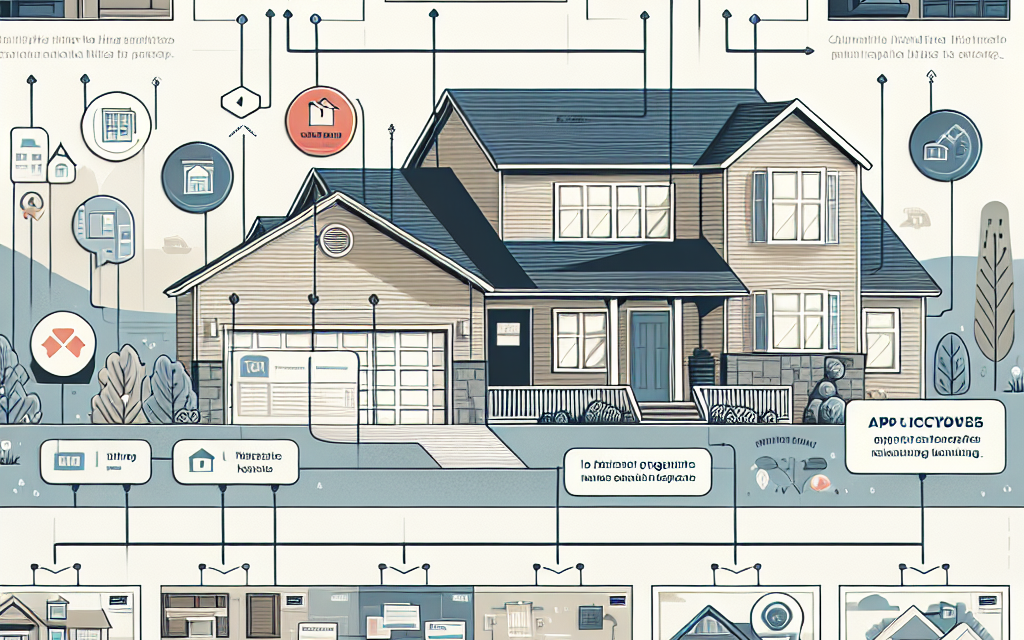“Unlock Your Dream Home: A Clear Guide to California’s First-Time Home Buyer Programs.”
Introduction
California’s First-Time Home Buyer Programs are designed to assist individuals and families in navigating the complexities of purchasing their first home. With rising housing costs and a competitive real estate market, these programs offer valuable resources, including financial assistance, down payment assistance, and educational workshops. By providing access to affordable financing options and support services, California aims to empower first-time buyers to achieve homeownership and build equity in their communities. This introduction outlines the various programs available, eligibility requirements, and the benefits they offer to prospective homeowners in the Golden State.
Overview Of California’s First-Time Home Buyer Programs
California’s housing market is known for its high prices and competitive nature, making it particularly challenging for first-time home buyers to enter the market. In response to these challenges, the state has developed a variety of programs designed to assist individuals and families in achieving their dream of homeownership. These programs aim to alleviate some of the financial burdens associated with purchasing a home, providing essential resources and support to those who may otherwise struggle to secure a mortgage or afford a down payment.
One of the most significant initiatives is the California Housing Finance Agency (CalHFA), which offers a range of loan programs specifically tailored for first-time buyers. These programs often include down payment assistance, which can be a critical factor for many buyers who find it difficult to save the necessary funds. For instance, CalHFA provides a Down Payment Assistance Program that offers a second mortgage to cover down payment and closing costs, making homeownership more accessible. This program is particularly beneficial for low to moderate-income families, as it helps bridge the gap between what they can afford and the actual costs of purchasing a home.
In addition to CalHFA, various local governments and nonprofit organizations across California have established their own first-time home buyer programs. These initiatives often include financial education workshops, which equip potential buyers with the knowledge and skills needed to navigate the home buying process. By understanding the intricacies of mortgages, credit scores, and budgeting, first-time buyers can make informed decisions that will benefit them in the long run. Furthermore, some local programs offer grants or forgivable loans to assist with down payments, further reducing the financial barriers to homeownership.
Moreover, California has implemented the Mortgage Credit Certificate (MCC) program, which provides first-time home buyers with a federal tax credit. This credit can significantly reduce the amount of federal income tax owed, thereby increasing the buyer’s disposable income and making it easier to qualify for a mortgage. By lowering the overall cost of homeownership, the MCC program serves as an attractive incentive for first-time buyers looking to invest in their future.
As the demand for affordable housing continues to rise, California’s first-time home buyer programs are evolving to meet the needs of its residents. For example, some programs are now focusing on specific demographics, such as veterans or individuals with disabilities, ensuring that assistance is available to those who may face additional challenges in the housing market. This targeted approach not only helps to create a more inclusive environment but also fosters a sense of community among diverse groups of home buyers.
In conclusion, California’s first-time home buyer programs play a crucial role in addressing the challenges faced by individuals and families seeking to purchase their first home. By offering financial assistance, educational resources, and targeted support, these programs empower potential buyers to navigate the complexities of the housing market with greater confidence. As the state continues to adapt to the evolving needs of its residents, these initiatives will remain vital in promoting homeownership and fostering economic stability within communities. Ultimately, the combination of state and local efforts reflects a commitment to making homeownership a reality for many Californians, paving the way for a brighter future.
Eligibility Requirements For First-Time Home Buyers
California’s first-time home buyer programs are designed to assist individuals and families in navigating the complexities of purchasing a home, particularly in a state where housing prices can be prohibitively high. Understanding the eligibility requirements for these programs is crucial for prospective buyers who wish to take advantage of the financial assistance and resources available to them. Generally, the term “first-time home buyer” refers to individuals who have not owned a home in the past three years. This definition is significant because it opens the door for many who may have previously owned a home but are now looking to re-enter the market after a period of renting or living in a different housing situation.
In addition to the first-time home buyer status, applicants must meet certain income limits, which vary depending on the specific program and the area in which they are looking to buy. These income limits are typically set as a percentage of the area median income (AMI) and are designed to ensure that assistance is directed toward those who need it most. For instance, many programs require that household income does not exceed 80% to 120% of the AMI, depending on the program’s focus and funding sources. Therefore, it is essential for potential buyers to assess their financial situation and determine whether they fall within these income thresholds.
Moreover, creditworthiness plays a pivotal role in the eligibility criteria for first-time home buyer programs. Most programs require applicants to have a minimum credit score, which can vary by lender and program. A higher credit score not only increases the likelihood of being approved for a loan but may also lead to more favorable loan terms, such as lower interest rates. Consequently, individuals interested in these programs should take proactive steps to improve their credit scores, if necessary, by paying down debts and ensuring timely payments on existing obligations.
Another important aspect of eligibility is the requirement for homebuyer education. Many programs mandate that applicants complete a homebuyer education course, which provides valuable information about the home buying process, financial management, and the responsibilities of homeownership. This requirement is beneficial, as it equips buyers with the knowledge they need to make informed decisions and helps to reduce the risk of future financial difficulties.
Additionally, prospective buyers should be aware of the specific property requirements associated with these programs. For instance, some programs may only apply to certain types of properties, such as single-family homes, condominiums, or townhouses, and may also impose limits on the purchase price of the home. These restrictions are intended to ensure that the assistance provided is used effectively and that buyers are investing in properties that are sustainable and suitable for their needs.
In conclusion, California’s first-time home buyer programs offer a lifeline to those looking to enter the housing market, but understanding the eligibility requirements is essential for success. By familiarizing themselves with the definitions of first-time home buyers, income limits, credit score expectations, homebuyer education mandates, and property restrictions, prospective buyers can better prepare themselves for the journey ahead. Ultimately, these programs aim to create pathways to homeownership, fostering stability and community growth in a state where the dream of owning a home can often feel out of reach.
Types Of Assistance Available For First-Time Buyers
California offers a variety of assistance programs designed to support first-time home buyers in navigating the complexities of the real estate market. These programs aim to alleviate some of the financial burdens associated with purchasing a home, making the dream of homeownership more attainable for many individuals and families. One of the primary forms of assistance available is down payment assistance, which can significantly reduce the upfront costs that often deter potential buyers. Various state and local programs provide grants or low-interest loans to help cover down payments, allowing buyers to enter the market with a more manageable financial commitment.
In addition to down payment assistance, many programs also offer help with closing costs. Closing costs can add thousands of dollars to the overall expense of purchasing a home, and for first-time buyers, these costs can be particularly daunting. Some programs provide financial aid specifically earmarked for closing costs, which can be a crucial factor in making homeownership feasible. By alleviating these additional expenses, first-time buyers can focus more on the long-term investment of their new home rather than the immediate financial hurdles.
Moreover, California has implemented various mortgage assistance programs that cater to first-time buyers. These programs often feature favorable loan terms, such as lower interest rates or reduced mortgage insurance requirements. For instance, the California Housing Finance Agency (CalHFA) offers several loan options that are specifically designed for first-time buyers, including the CalHFA FHA Loan Program and the CalHFA VA Loan Program. These loans not only provide competitive rates but also come with the added benefit of being more accessible to those with limited credit histories or lower income levels.
Furthermore, some programs are tailored to specific demographics, such as veterans, teachers, or public service employees. These targeted initiatives recognize the unique challenges faced by these groups and offer specialized assistance to help them achieve homeownership. For example, the California Department of Veterans Affairs provides programs that assist veterans in purchasing homes, ensuring that those who have served the country can secure a stable living environment.
In addition to financial assistance, educational resources are also a vital component of California’s first-time home buyer programs. Many organizations offer workshops and counseling sessions that equip buyers with the knowledge they need to make informed decisions throughout the home-buying process. These educational initiatives cover essential topics such as budgeting, understanding credit scores, and navigating the mortgage application process. By empowering buyers with information, these programs help to foster a more confident and informed approach to homeownership.
As the housing market continues to evolve, California’s first-time home buyer programs remain a crucial resource for those looking to purchase their first home. By providing a combination of financial assistance, favorable loan options, and educational resources, these programs work to create a more inclusive housing market. Ultimately, they aim to ensure that the dream of homeownership is not just a distant aspiration but a tangible reality for many Californians. As potential buyers explore their options, understanding the types of assistance available can be the first step toward achieving their goal of owning a home in this diverse and vibrant state.
How To Apply For First-Time Home Buyer Programs
Applying for first-time home buyer programs in California can be a pivotal step toward achieving homeownership, especially for those who may find the traditional housing market daunting. Understanding the application process is essential, as it can help streamline your journey and ensure that you take full advantage of the resources available to you. To begin with, it is crucial to familiarize yourself with the various programs offered by both state and local agencies. California provides a range of options, including down payment assistance, mortgage credit certificates, and low-interest loans, each designed to cater to different financial situations and needs.
Once you have identified the programs that align with your circumstances, the next step is to gather the necessary documentation. Typically, this includes proof of income, tax returns, bank statements, and information regarding your credit history. It is advisable to maintain organized records, as this will facilitate a smoother application process. Additionally, many programs require applicants to complete a homebuyer education course. This course not only equips you with essential knowledge about the home buying process but also demonstrates your commitment to responsible homeownership, which can be beneficial when applying for assistance.
After preparing your documentation and completing any required courses, you can begin the application process. Most programs allow you to apply online, which can be a convenient option. However, some may require you to work through approved lenders or housing agencies. It is important to carefully read the application instructions for each program, as they may vary significantly. In some cases, you may need to submit your application directly to a housing agency, while in others, your lender may handle the submission on your behalf.
As you submit your application, be prepared for a waiting period during which the agency or lender reviews your information. This process can take anywhere from a few days to several weeks, depending on the program and the volume of applications being processed. During this time, it is advisable to remain proactive by maintaining communication with your lender or the housing agency. This not only demonstrates your eagerness but also allows you to address any potential issues that may arise during the review process.
Once your application has been approved, you will receive a notification detailing the terms of the assistance you qualify for. It is essential to review this information carefully, as it will outline the specific benefits you can expect, such as the amount of down payment assistance or the interest rate on your mortgage. Understanding these terms will enable you to make informed decisions as you move forward in the home buying process.
In conclusion, applying for first-time home buyer programs in California involves several key steps, including identifying suitable programs, gathering necessary documentation, completing required courses, and submitting your application. By approaching this process with diligence and organization, you can enhance your chances of securing the assistance you need to make homeownership a reality. As you navigate this journey, remember that resources are available to guide you, and taking advantage of these programs can significantly ease the financial burden of purchasing your first home. Ultimately, with careful planning and informed decision-making, you can successfully transition from aspiring homeowner to proud property owner in California.
Benefits Of California’s First-Time Home Buyer Programs
California’s first-time home buyer programs offer a multitude of benefits designed to assist individuals and families in navigating the often daunting process of purchasing a home. One of the most significant advantages of these programs is the financial assistance they provide, which can alleviate some of the burdens associated with down payments and closing costs. Many first-time buyers struggle to save enough money to cover these expenses, and California’s initiatives aim to bridge that gap. For instance, programs such as the California Housing Finance Agency (CalHFA) offer down payment assistance loans that can significantly reduce the upfront costs, making homeownership more accessible.
In addition to financial assistance, these programs often include favorable loan terms that can enhance affordability. Many first-time home buyer programs in California feature lower interest rates compared to conventional loans, which can lead to substantial savings over the life of the mortgage. Furthermore, some programs allow for reduced mortgage insurance premiums, which can further decrease monthly payments. This combination of lower rates and reduced insurance costs can make a significant difference in a buyer’s overall financial commitment, allowing them to allocate resources to other essential areas of their lives.
Moreover, California’s first-time home buyer programs frequently provide educational resources that empower buyers with the knowledge they need to make informed decisions. Homebuyer education courses are often a prerequisite for program participation, equipping individuals with essential skills and insights into the home buying process. These courses cover a range of topics, including budgeting, credit management, and the intricacies of mortgage financing. By fostering a deeper understanding of the real estate market and the responsibilities of homeownership, these educational components help buyers feel more confident and prepared as they embark on their journey.
Another notable benefit of California’s first-time home buyer programs is the flexibility they offer in terms of eligibility criteria. Many programs are designed to accommodate a diverse range of income levels and family situations, recognizing that the path to homeownership is not one-size-fits-all. This inclusivity allows a broader spectrum of individuals to take advantage of the available resources, thereby increasing the likelihood of successful homeownership among first-time buyers. Additionally, some programs are tailored to specific demographics, such as veterans or low-income families, ensuring that assistance is directed where it is most needed.
Furthermore, these programs often promote sustainable homeownership by encouraging buyers to consider properties that are not only affordable but also suitable for long-term living. Many initiatives emphasize the importance of purchasing homes in stable neighborhoods with access to essential services, schools, and employment opportunities. This focus on community well-being not only benefits the buyers but also contributes to the overall health of California’s housing market.
In conclusion, California’s first-time home buyer programs present a comprehensive array of benefits that can significantly ease the transition into homeownership. From financial assistance and favorable loan terms to educational resources and inclusive eligibility criteria, these programs are designed to support individuals and families in achieving their homeownership dreams. By addressing the unique challenges faced by first-time buyers, California is fostering a more equitable housing landscape, ultimately contributing to the stability and vibrancy of its communities. As prospective homeowners explore their options, understanding these benefits can empower them to make informed choices that align with their financial goals and lifestyle aspirations.
Common Misconceptions About First-Time Home Buyer Programs
When considering the prospect of purchasing a home for the first time, many potential buyers often encounter a myriad of misconceptions surrounding first-time home buyer programs. These misunderstandings can create unnecessary barriers and deter individuals from taking advantage of the resources available to them. One prevalent misconception is that these programs are exclusively for low-income individuals. While it is true that many programs are designed to assist those with limited financial means, there are also options available for moderate-income buyers. In fact, California offers a variety of programs that cater to different income levels, ensuring that a broader range of first-time buyers can benefit from financial assistance.
Another common myth is that first-time home buyer programs require a significant down payment. In reality, many of these programs are designed to help buyers with down payment assistance, which can significantly reduce the initial financial burden. For instance, some programs offer grants or low-interest loans that can cover a portion of the down payment, making homeownership more accessible. This misconception often leads potential buyers to believe that they must save for years before they can even consider purchasing a home, when in fact, they may be closer to homeownership than they realize.
Additionally, some individuals mistakenly believe that first-time home buyer programs are overly complicated and difficult to navigate. While it is true that the application process can involve various steps and requirements, many organizations and agencies provide resources and support to guide buyers through the process. From workshops to one-on-one counseling, these resources can demystify the application process and help buyers understand their options. Furthermore, many lenders are well-versed in these programs and can assist buyers in finding the right fit for their financial situation.
Moreover, there is a misconception that first-time home buyer programs are only available for specific types of properties. While certain programs may have restrictions regarding property types, many are flexible and can be applied to a wide range of housing options, including single-family homes, condominiums, and even some multi-family units. This flexibility allows buyers to explore various housing markets and find a home that meets their needs without being limited by program restrictions.
Another misunderstanding is that first-time home buyer programs are only beneficial for those who plan to stay in their homes for an extended period. While it is true that some programs may have stipulations regarding resale or refinancing, many do not impose such restrictions. Buyers should carefully review the terms of each program to understand any potential implications for future home sales or refinancing options. This knowledge can empower buyers to make informed decisions about their investments.
Finally, some potential buyers may believe that they are ineligible for first-time home buyer programs simply because they have previously owned a home. However, many programs define “first-time home buyer” more broadly, allowing individuals who have not owned a home in the past three years to qualify. This inclusive definition opens the door for many individuals who may have previously owned a home but are now looking to re-enter the market.
In conclusion, dispelling these common misconceptions about first-time home buyer programs is essential for empowering potential buyers. By understanding the true nature of these programs, individuals can make informed decisions and take advantage of the resources available to them, ultimately paving the way toward successful homeownership in California.
Success Stories: First-Time Home Buyers In California
California’s housing market is often perceived as daunting, particularly for first-time home buyers who may feel overwhelmed by high prices and competitive bidding wars. However, numerous success stories illustrate that with the right resources and support, achieving homeownership in the Golden State is indeed possible. These narratives not only inspire hope but also highlight the effectiveness of various first-time home buyer programs available throughout California.
One notable success story involves a young couple, Sarah and David, who had long dreamed of owning a home in the vibrant city of San Diego. Like many first-time buyers, they faced the challenge of rising property prices and limited inventory. However, they discovered the California Housing Finance Agency (CalHFA) and its programs designed specifically for first-time buyers. By taking advantage of CalHFA’s MyHome Assistance Program, they received a down payment assistance loan that significantly reduced their initial financial burden. This support allowed them to secure a charming two-bedroom condo in a neighborhood they loved, transforming their dream into reality.
Similarly, in the bustling Bay Area, another couple, Maria and Juan, found themselves navigating the complexities of home buying. With a combined income that placed them above the poverty line but still below the threshold for many traditional loans, they felt stuck in a cycle of renting. However, they learned about the California Dream For All program, which offers shared equity financing to help first-time buyers purchase homes. This innovative approach allowed them to buy a modest home in Oakland, with the state sharing in the appreciation of the property. As a result, they not only achieved homeownership but also positioned themselves for future financial stability.
Moreover, the success stories extend beyond couples to include individuals like Lisa, a single mother who was determined to provide a stable home for her children. After years of renting and saving, she discovered the HomeReady mortgage program, which caters to low-to-moderate income borrowers. This program enabled her to secure a mortgage with a lower down payment and reduced mortgage insurance costs. With the assistance of a local nonprofit organization that offered homebuyer education classes, Lisa gained the knowledge and confidence needed to navigate the home buying process. Ultimately, she purchased a cozy three-bedroom house in a family-friendly neighborhood, fulfilling her aspiration of homeownership while ensuring a nurturing environment for her children.
These success stories underscore the importance of community resources and educational programs that empower first-time home buyers. Organizations across California provide invaluable support, from financial counseling to workshops that demystify the home buying process. By leveraging these resources, aspiring homeowners can make informed decisions and avoid common pitfalls.
In conclusion, the experiences of Sarah, David, Maria, Juan, and Lisa serve as powerful reminders that homeownership is attainable, even in California’s competitive market. Through various first-time home buyer programs, individuals and families can access the financial assistance and educational resources necessary to navigate the complexities of purchasing a home. As more success stories emerge, they not only inspire others to pursue their dreams of homeownership but also highlight the critical role that supportive programs play in making these dreams a reality. With determination and the right tools, first-time home buyers in California can turn their aspirations into tangible achievements, contributing to the diverse tapestry of communities across the state.
Q&A
1. **What are California’s First-Time Home Buyer Programs?**
California’s First-Time Home Buyer Programs are initiatives designed to assist first-time homebuyers in purchasing a home through financial assistance, education, and various loan options.
2. **Who qualifies as a first-time homebuyer in California?**
A first-time homebuyer is typically defined as someone who has not owned a home in the last three years, including individuals and families.
3. **What types of financial assistance are available?**
Assistance can include down payment assistance, closing cost assistance, and low-interest loans, often provided through state and local programs.
4. **Are there income limits for these programs?**
Yes, most programs have income limits based on the area’s median income, which varies by location and family size.
5. **What is the California Housing Finance Agency (CalHFA)?**
CalHFA is a state agency that offers various loan programs and financial assistance specifically for first-time homebuyers in California.
6. **Do first-time homebuyers need to complete a homebuyer education course?**
Yes, many programs require participants to complete a homebuyer education course to ensure they understand the home buying process.
7. **How can first-time homebuyers apply for these programs?**
First-time homebuyers can apply through approved lenders or local housing agencies that participate in the state’s homebuyer assistance programs.
Conclusion
California’s First-Time Home Buyer Programs provide essential resources and financial assistance to help individuals and families achieve homeownership. These programs offer various benefits, including down payment assistance, low-interest loans, and educational resources, making it easier for first-time buyers to navigate the complex real estate market. By addressing affordability challenges and promoting access to housing, these initiatives play a crucial role in supporting the dreams of many Californians seeking to own their first home. Overall, California’s commitment to facilitating homeownership reflects its recognition of housing as a fundamental need and a key component of community stability and growth.





